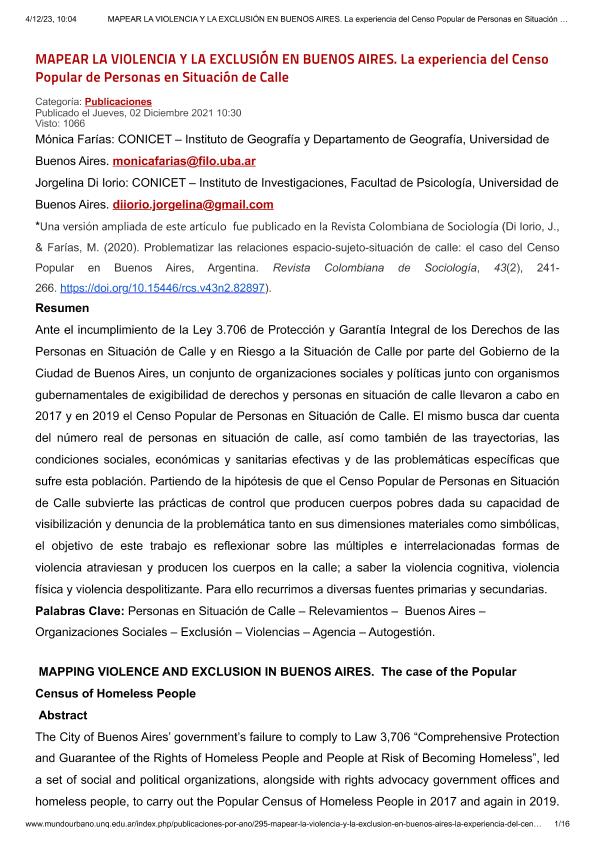Artículo
Ante el incumplimiento de la Ley 3.706 de Protección y Garantía Integral de los Derechos de las Personas en Situación de Calle y en Riesgo a la Situación de Calle por parte del Gobierno de la Ciudad de Buenos Aires, un conjunto de organizaciones sociales y políticas junto con organismos gubernamentales de exigibilidad de derechos y personas en situación de calle llevaron a cabo en 2017 y en 2019 el Censo Popular de Personas en Situación de Calle. El mismo busca dar cuenta del número real de personas en situación de calle, así como también de las trayectorias, las condiciones sociales, económicas y sanitarias efectivas y de las problemáticas específicas que sufre esta población. Partiendo de la hipótesis de que el Censo Popular de Personas en Situación de Calle subvierte las prácticas de control que producen cuerpos pobres dada su capacidad de visibilización y denuncia de la problemática tanto en sus dimensiones materiales como simbólicas, el objetivo de este trabajo es reflexionar sobre las múltiples e interrelacionadas formas de violencia atraviesan y producen los cuerpos en la calle; a saber la violencia cognitiva, violencia física y violencia despolitizante. Para ello recurrimos a diversas fuentes primarias y secundarias. The paper describes the methodological and ethic-political dimensions of the Popular Census of Homeless People conducted in the City of Buenos Aires (Argentina) in 2017 and 2019. Law 3706 establishes that the government of the city has to conduct an “annual survey of homeless people and people at risk of becoming homeless that provides disaggregated information that helps to diagnose and come up with specific politics for different subgroups” (Government of the City of Buenos Aires, 2010). Given the fact that the Government of the City of Buenos Aires does not comply with that law, a group of social and political organizations alongside three advocacy rights government offices at the local level and homeless people organized and carried out two Popular Census of Homeless People. We resort to the extended case method or situational analysis (Martínez, 2017) to present the Popular Census (pc) as a case to discuss the methodologies for counting homeless people and to make visible the collective organizational potential that functions as a tool for social and political change. The results of the 2017 and 2019 pcs are not discussed here, but we analyze the ways in which the pc exposes forms of social participation as well as different forms of violence exerted over the homeless people, achieved through the analysis of primary and secondary sources. We conclude that the pc transcends what is called census-event and becomes a censusmovement. That is a group of social, political, and neighborhood organizations that grows into a social actor with the ability to conduct actions before, during, and after the censusevent. The census-movement becomes an alternative that objects the established ways of coding the complex problem of homelessness and provides the opportunity for processes of singularization to emerge (Giattari & Rolnik, 2013). These processes of singularization allow the appearance of sensitivities and creativity from where to produce resistant and desiring subjectivities.
Mapear la violencia y la exclusión en Buenos Aires: La experiencia del Censo Popular de Personas en Situación de Calle
Título:
Mapping violence and exclusion in Buenos Aires: The case of the Popular Census of Homeless People
Fecha de publicación:
10/2021
Editorial:
Universidad Nacional de Quilmes
Revista:
Mundo Urbano
ISSN:
1515-8373
Idioma:
Español
Tipo de recurso:
Artículo publicado
Clasificación temática:
Resumen
Archivos asociados
Licencia
Identificadores
Colecciones
Articulos(SEDE CENTRAL)
Articulos de SEDE CENTRAL
Articulos de SEDE CENTRAL
Citación
Farías, Mónica Isabel; Di Iorio, Jorgelina; Mapear la violencia y la exclusión en Buenos Aires: La experiencia del Censo Popular de Personas en Situación de Calle; Universidad Nacional de Quilmes; Mundo Urbano; 10-2021; 1-16
Compartir




